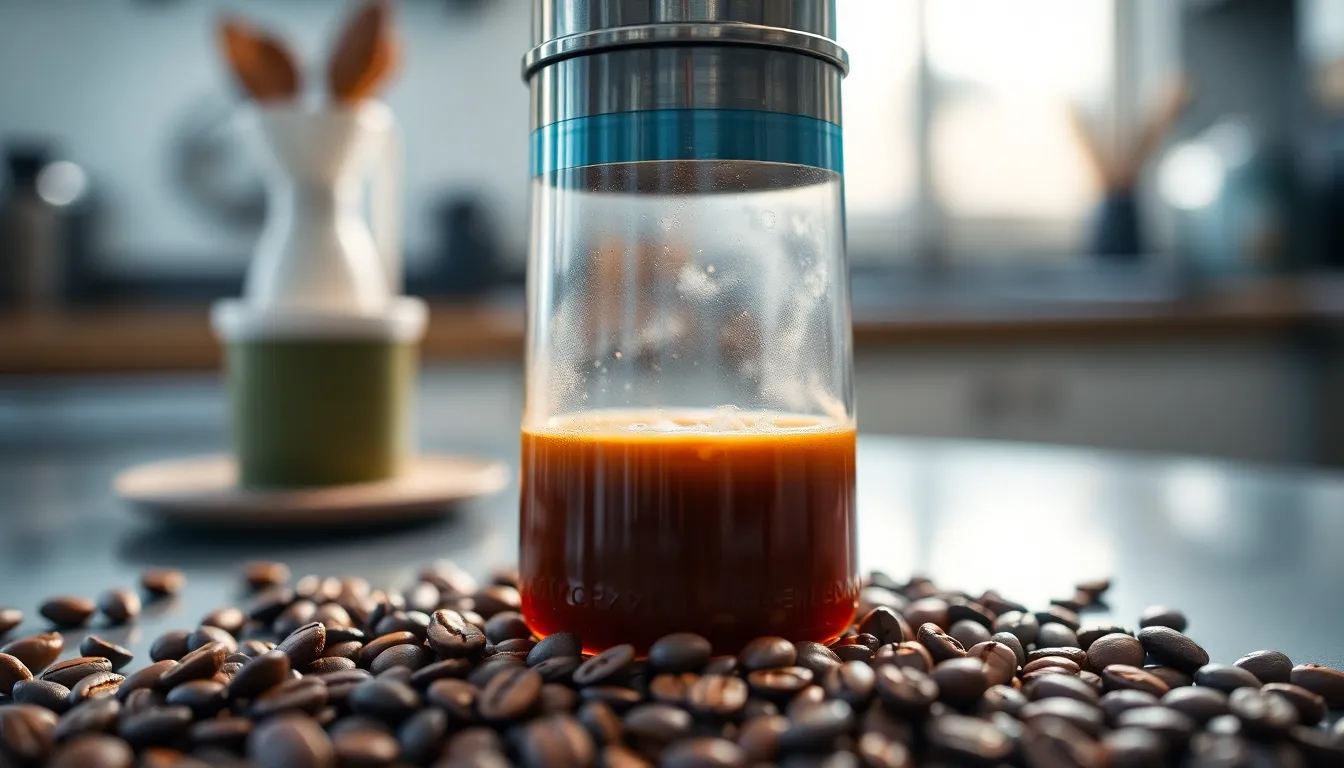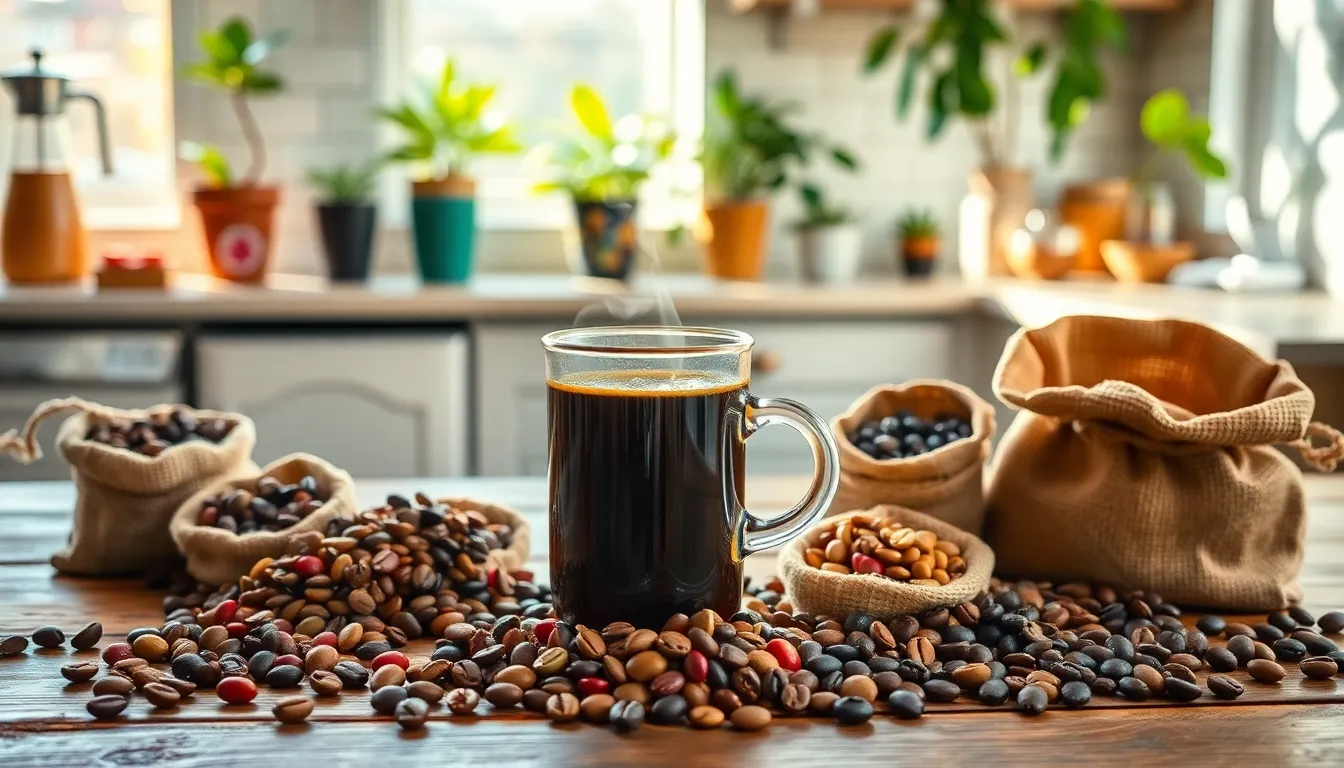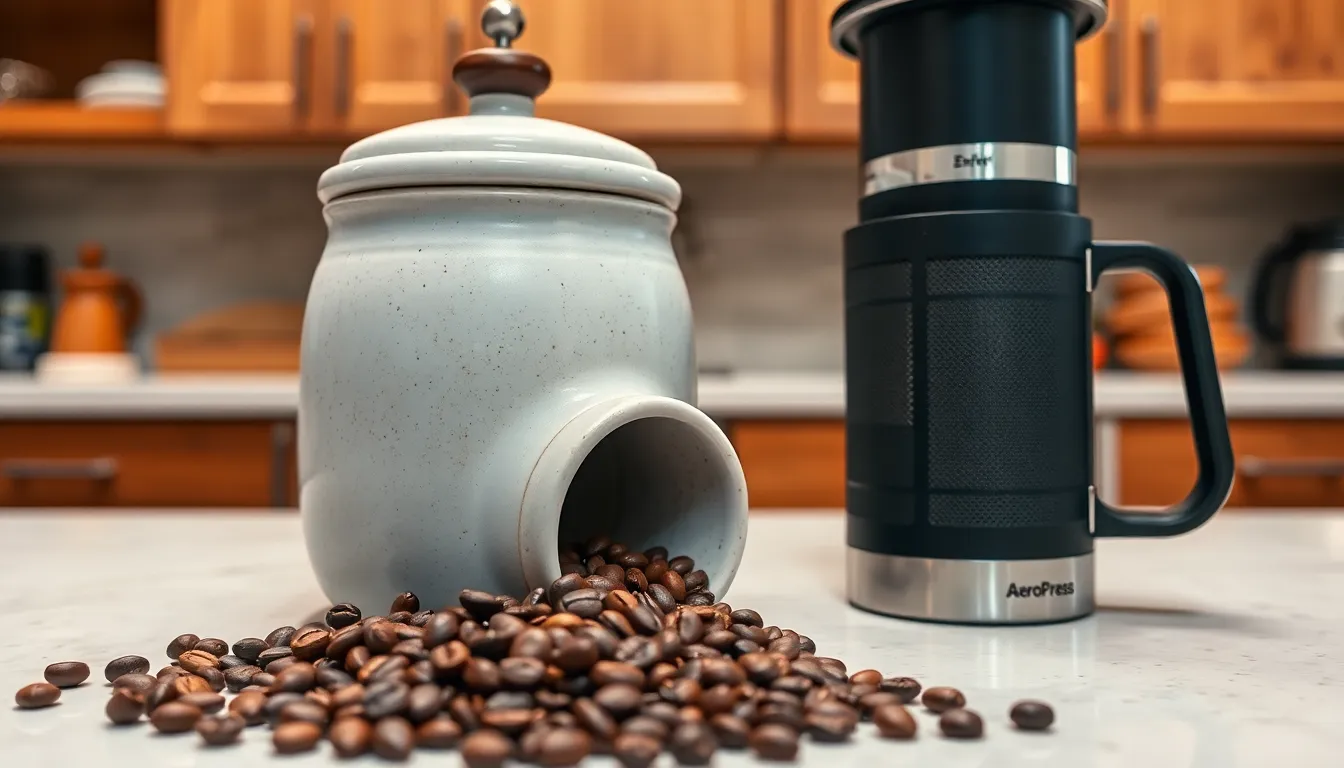Are you searching for the best coffee beans for AeroPress that’ll transform your morning ritual? The perfect bean can make all the difference between a mediocre cup and a mind-blowing brew experience.
AeroPress brewing has gained massive popularity among coffee enthusiasts for good reason—it’s versatile, quick, and extracts incredible flavor when paired with the right beans. Whether you prefer bright, fruity notes or rich, chocolatey profiles, finding beans specifically suited to this brewing method will elevate your coffee game. The unique pressure brewing system of the AeroPress works exceptionally well with certain roast levels and origins that might surprise you.
What Makes Coffee Beans Perfect for Aeropress
AeroPress brewing demands exact bean characteristics to achieve that perfect cup. Medium to medium-dark roast coffee beans typically excel in this brewing method because they balance acidity and body while highlighting complex flavor notes. These roast levels extract efficiently under the AeroPress’s unique pressure system.
Single-origin beans often outperform blends in an AeroPress setup, revealing distinct regional characteristics with remarkable clarity. Beans from Ethiopia showcase vibrant fruity notes, while Colombian varieties deliver balanced chocolate and caramel undertones that shine through the AeroPress’s paper filter.
Freshness plays a crucial role in AeroPress brewing success. Coffee beans used 7-21 days after roasting offer optimal flavor development without the overwhelming carbon dioxide release of extremely fresh beans. This timing allows the AeroPress to extract maximum flavor compounds during its brief brewing cycle.
Grind consistency directly impacts extraction quality in your AeroPress. Medium-fine grinds similar to table salt provide ideal surface area for the short brewing time, promoting even extraction without over-extraction bitterness. High-quality burr grinders achieve this consistency better than blade grinders, making them a worthwhile investment for AeroPress enthusiasts.
Understanding Aeropress Brewing and Bean Selection

The AeroPress brewing method creates smooth, rich coffee with minimal bitterness by combining immersion and gentle pressure. This unique extraction process efficiently pulls flavors and oils from coffee grounds in under a minute, making it an exceptional brewing device for highlighting bean characteristics.
Grind Size Considerations for AeroPress
AeroPress brewing requires a finer grind than typical drip coffee methods to achieve optimal extraction. A super fine grind—approaching espresso fineness—works best due to the short brew time, allowing coffee particles to release maximum flavor quickly. This fine consistency enables the pressure and immersion components of the AeroPress to extract rich flavors without pulling unwanted bitterness from the beans. Your grind setting significantly impacts your brew’s taste profile, with finer grinds producing more intense, concentrated flavors that showcase the bean’s natural characteristics.
Roast Profiles That Shine in AeroPress
Medium to dark roasts excel in AeroPress brewing, particularly those featuring chocolate, nuts, caramel, and molasses flavor notes. These roast profiles deliver smooth, rich cups with satisfying body when brewed in an AeroPress. Dark roasts with mild acidity and full body perform exceptionally well, especially those from robusta or arabica blends. Cafely’s HaNoi beans, a 100% robusta dark roast, exemplify ideal AeroPress candidates with their earthy, malty notes that shine through the clean filtration process. Balanced blends like Cafely DaNang, combining robusta and arabica beans, offer complex nutty, sweet, and citrus notes that the AeroPress preserves beautifully. Beans with chocolate, cherry, fig, hazelnut, or maple syrup tasting notes are particularly enhanced by AeroPress brewing, as the method emphasizes clarity while maintaining complexity in the cup.
Top Light Roast Coffee Beans for Aeropress

Light roast coffees shine in the AeroPress brewing method because this immersion-pressure system preserves their delicate flavor profiles while minimizing bitterness. The AeroPress’s unique brewing process extracts the essential oils and complex notes from light roasts that might get lost in other brewing methods. Let’s explore the best light roast options for your AeroPress.
Fruity and Floral Options
Ethiopian and Kenyan single-origin beans offer the most vibrant fruity and floral profiles for AeroPress brewing. These high-altitude Arabica varieties deliver clear berry, citrus, and jasmine notes that the AeroPress gently extracts without muddying their complexity. Look for coffee beans specifically labeled with tasting notes like “blueberry,” “bergamot,” or “honeysuckle” from specialty roasters. Single-origin Ethiopian Yirgacheffe beans particularly excel in the AeroPress, producing cups with distinct apricot and floral aromatics that remain bright and clean thanks to the paper filter’s ability to remove excess oils.
Bright and Acidic Selections
Light roast Arabica beans from Central American regions like Guatemala and Costa Rica provide the bright, wine-like acidity that makes AeroPress coffee so distinctive. These beans typically feature apple, grape, or lemon-like acidity that creates a crisp, refreshing cup when brewed with an AeroPress. The shorter brewing time (typically 1-1.5 minutes) preserves these acidic notes without extracting bitter compounds. For maximum brightness, try beans from high-elevation farms above 1,500 meters, as the dense bean structure concentrates complex acids that contribute to a vibrant flavor profile. The AeroPress’s paper filter captures the micro-particles that might otherwise cloud these bright notes, resulting in a clean cup that showcases the coffee’s natural vibrancy.
Medium Roast Champions for Aeropress Brewing

Medium roast coffee beans have earned their reputation as the ultimate choice for AeroPress brewing. These roasts offer the perfect intersection of flavor complexity and approachability, making them especially suitable for this versatile brewing method.
Balanced Flavor Profiles
Medium roasts provide an ideal balance between the bright acidity of light roasts and the bold intensity of dark roasts. This equilibrium creates a cup with inviting aromas, complex flavor notes, and moderate acidity that perfectly complements the AeroPress brewing technique. When brewed in an AeroPress, medium roast beans release chocolate, nut, and caramel undertones while maintaining subtle fruity highlights. The AeroPress’s short brew time and pressure-based extraction particularly enhance these balanced profiles, allowing all flavor components to shine without any single element overwhelming the cup.
Versatile All-Day Drinkers
Medium roast coffee beans serve as exceptional all-day companions for AeroPress users. Their approachable flavor profile satisfies coffee enthusiasts without the potential harshness that might come with darker roasts. The medium-fine grind recommended for AeroPress brewing (finer than drip but coarser than espresso) works perfectly with these roasts, enabling even extraction and a smooth, satisfying cup. Many coffee lovers appreciate how these beans maintain their complexity throughout the day without causing flavor fatigue. Specialty coffee brands like Danger Coffee offer medium roast whole beans specifically designed for AeroPress brewing, using remineralized waters to further enhance the natural flavors in each cup.
Dark Roast Contenders for Rich Aeropress Coffee

Dark roast coffee beans deliver a bold, satisfying experience in your Aeropress, producing cups with deep, robust flavors that many coffee enthusiasts crave. These darker roasts excel in Aeropress brewing by creating rich, full-bodied coffee with pronounced chocolate and caramel undertones. Coffee connoisseurs who prefer strong, intense flavors find dark roasts particularly appealing when using the Aeropress method.
Flavor Profile Advantages
Dark roasts provide distinctive flavor characteristics that shine through Aeropress extraction. Their rich chocolate notes become more pronounced when brewed with gentle pressure, creating a velvety mouthfeel. Caramel undertones emerge with remarkable clarity, offering a natural sweetness that balances the robust nature of dark-roasted beans. Drip coffee and espresso lovers typically gravitate toward these roasts for their intense flavor profile and reduced acidity.
Regional Standouts
Beans from Costa Rica’s Tarrazu region stand out as exceptional choices for dark roast Aeropress brewing. These beans maintain their smoothness even when deeply roasted, providing quality cups with complex flavor notes. Latin American origins contribute distinct nutty and chocolatey characteristics that complement the Aeropress brewing style perfectly. Coffee from these regions retains its flavor integrity even with darker roasting levels, making them ideal for those seeking a bold yet balanced cup.
Brewing Considerations
Dark roast beans require exact brewing parameters to maximize their potential in an Aeropress. Shorter brew times often work best, extracting the rich flavors without introducing excessive bitterness. Water temperature adjustments (slightly lower than for lighter roasts) help optimize extraction of the bold, smoky notes characteristic of dark roasts. Freshness remains crucial, with beans used within days of roasting delivering superior results that showcase the deep, complex flavor profile dark roasts are known for.
Single-Origin vs. Blends for Aeropress

Single-Origin Beans
Single-origin beans come from one exact region or farm, offering distinct flavor profiles that reflect their unique growing environment. These beans highlight bright acidity, floral or fruity notes, and complexity that AeroPress brewing excels at extracting. The clean, precise extraction method of the AeroPress perfectly showcases the character and nuanced flavors present in high-quality single-origin beans. Specialty Arabic coffees with their complex tasting notes particularly shine when brewed through an AeroPress, allowing you to experience the full spectrum of flavors from a particular region.
Blends
Coffee blends combine beans from different origins or varieties (often arabica and robusta) to create a balanced cup with consistent flavor profiles. These carefully crafted combinations offer strength, body, and smoothness while offsetting potential bitterness and improving sweetness. Blends with a good balance of robusta and arabica perform exceptionally well in an AeroPress, delivering rich, full-bodied coffee with layered flavors. Cafely’s HaNoi, a 100% robusta dark roast, exemplifies this perfectly with its full body and intense earthy, malty notes that AeroPress brewing enhances. Their DaNang blend (50% arabica and 50% robusta) offers a smooth, bold cup with nutty and citrus highlights, demonstrating how well-crafted blends create complex yet balanced profiles in an AeroPress.
Roast and Grind Considerations
Medium to dark roasts have gained popularity among AeroPress enthusiasts for their reduced acidity and smooth taste profiles. The AeroPress company recommends using a super fine grind, approaching espresso fineness, to optimize extraction during the relatively short brew time. Starting with high-quality beans that are already smooth and flavorful is essential, as the AeroPress enhances rather than masks the inherent qualities of your coffee. The brewing method’s combination of immersion and pressure works particularly well with both single-origin and blended beans when ground appropriately.
Choosing Based on Your Preferences
Use single-origin beans when exploring bright, complex flavor profiles and wanting to experience the unique characteristics of exact growing regions. Choose blends for richer, more balanced, full-bodied coffee with consistent quality from cup to cup. Both options perform excellently with AeroPress brewing, with your selection eventually depending on your taste preferences and desired cup style. The AeroPress’s versatility makes it an ideal brewing method for experimenting with both single-origin beans and carefully crafted blends to discover your perfect cup.
How to Store Your Coffee Beans for Optimal Aeropress Results

Proper storage extends your coffee beans’ lifespan and preserves the qualities that make them perfect for AeroPress brewing. Fresh beans translate directly to richer flavors, more pronounced aromas, and that perfect cup you’re seeking every morning.
Use Airtight Containers
Oxygen rapidly degrades coffee quality by breaking down essential oils responsible for flavor. Invest in containers with secure seals that prevent air exposure completely. Ceramic or opaque glass containers work exceptionally well by blocking both air and light simultaneously.
Keep Away From Light and Heat
Sunlight and heat accelerate the deterioration of coffee beans’ complex flavor compounds. Store your containers in a cabinet or pantry away from windows and heat sources like ovens or stovetops. Maintaining consistent, cool temperatures preserves the delicate flavor notes that make AeroPress coffee so distinctive.
Avoid Refrigeration
Refrigerators seem like logical storage locations, but they actually harm your beans. Coffee readily absorbs odors from surrounding foods, and the condensation that forms when moving beans between temperatures introduces moisture that degrades quality. Room temperature storage in a dark place yields much better results for your AeroPress brews.
Buy Smaller Quantities
Coffee reaches peak flavor within 1-2 weeks after roasting. Purchase only what you’ll brew within this timeframe rather than stockpiling larger amounts. This approach ensures you’re always using beans at their flavor peak, which particularly matters for the clean, nuanced extraction the AeroPress delivers.
Maintain Proper Grinding Practices
Grind your beans immediately before brewing rather than pre-grinding your entire supply. Whole beans retain their integrity much longer than ground coffee, which can lose important flavor within minutes of grinding. This practice delivers maximum flavor extraction during the AeroPress’s short brew cycle.
Budget-Friendly vs. Premium Coffee Beans for Aeropress

Budget-friendly beans deliver remarkable Aeropress results without straining your wallet. Robusta blends, like Cafely HaNoi, provide intense, full-bodied flavors with rich earthiness at a lower price point than specialty options. These value-oriented beans often contain higher robusta content, creating strong cups with pronounced malty notes that pair exceptionally well with the Aeropress’s filtration system.
Premium beans offer complex aromatic profiles and nuanced flavor experiences for discerning coffee enthusiasts. Single-origin specialty beans, particularly medium roasts featuring chocolate, nut, or caramel notes, showcase their distinctive characteristics beautifully through the Aeropress brewing method. These higher-end options reveal subtle flavor complexities that budget options might not deliver, though at a higher cost.
Regardless of price point, freshness remains the critical factor in Aeropress brewing success. Whole beans ground immediately before brewing preserve essential oils and aromatics that pre-ground coffee quickly loses. A fine grind, approaching espresso consistency, enables short brew times and smooth extraction that brings out the best in both budget and premium beans.
Balanced blends like Cafely DaNang (50% robusta, 50% arabica) represent an excellent middle ground, offering nutty sweetness with bright citrus notes at a reasonable price. This combination creates a smooth yet vibrant cup that demonstrates how even moderately priced beans can yield exceptional Aeropress results when properly selected and prepared.
Conclusion
Your AeroPress journey deserves the perfect beans to match its unique brewing capabilities. Whether you prefer the bright complexity of Ethiopian single-origin light roasts or the rich boldness of Costa Rican dark roasts a industry of flavor awaits your exploration.
Remember that freshness timing and proper storage significantly impact your cup quality. Invest in a quality burr grinder for consistent medium-fine grounds and don’t shy away from experimenting with different bean varieties.
From budget-friendly robusta blends to premium single-origin selections the AeroPress’s versatile brewing method can extract exceptional flavors from various beans. Trust your taste preferences and enjoy the process of discovering your perfect AeroPress companion.
The perfect cup is just a brew away!
Frequently Asked Questions
What makes AeroPress coffee brewing special?
AeroPress brewing combines immersion and gentle pressure to create smooth, rich coffee with minimal bitterness. This versatile brewing method extracts complex flavors effectively while allowing you to control variables like grind size, water temperature, and brewing time. The result is a clean cup that showcases the unique characteristics of your chosen coffee beans.
Which roast level works best for AeroPress?
Medium roasts are generally considered ideal for AeroPress, offering the perfect balance between bright acidity and rich body. However, the AeroPress is versatile enough to work well with light roasts (for fruity, floral notes) and dark roasts (for chocolate, caramel flavors). Your preference should guide your choice, as each roast level can produce excellent results.
Are single-origin beans better than blends for AeroPress?
Single-origin beans showcase distinct regional characteristics and complex flavor profiles that the AeroPress preserves beautifully. However, blends can offer balanced, consistent cups with enhanced sweetness. Neither is objectively “better” – single-origins highlight unique flavors while blends provide reliability. Choose based on whether you prefer exploring distinctive regional notes or enjoying consistent flavor profiles.
What grind size should I use for AeroPress?
A medium-fine grind, approaching espresso fineness, works best for AeroPress brewing. This grind size allows for optimal extraction during the short brew time while preventing over-extraction. Use a high-quality burr grinder for consistent particle size, which is crucial for even extraction and balanced flavor development.
How fresh should coffee beans be for AeroPress?
Coffee beans are optimal for AeroPress brewing when used 7-21 days after roasting. This rest period allows beans to degas while retaining essential oils and flavors. Extremely fresh beans (under 7 days) may produce inconsistent results due to ongoing degassing, while beans older than a month typically lose their vibrant flavor profiles and aromatic compounds.
What are the best Ethiopian beans for AeroPress?
Ethiopian beans, especially from Yirgacheffe and Sidamo regions, excel in AeroPress brewing by delivering vibrant berry and floral notes with wine-like acidity. These light to medium roast beans showcase distinctive fruity profiles including blueberry, strawberry, and citrus notes. The AeroPress’s gentle extraction method preserves these delicate flavors while minimizing any potential harshness.
Can I use dark roast coffee in an AeroPress?
Absolutely! Dark roast coffee works excellently in an AeroPress, producing bold cups with pronounced chocolate and caramel notes. For best results, use slightly lower water temperatures (185-190°F) and shorter brew times to avoid excessive bitterness. Costa Rican Tarrazu and Indonesian dark roasts are particularly good choices, offering robust flavor while maintaining smoothness.
How should I store coffee beans for AeroPress brewing?
Store coffee beans in an opaque, airtight container away from light, heat, and moisture. Keep at room temperature rather than refrigerating to prevent condensation. Buy smaller quantities more frequently, and grind only what you need immediately before brewing. Proper storage preserves essential oils and aromatic compounds that contribute to a flavorful AeroPress cup.
Are expensive coffee beans worth it for AeroPress?
Premium beans often offer more complex flavor profiles and nuanced tasting notes that the AeroPress can highlight effectively. However, moderately priced beans like balanced blends can also produce excellent results. Freshness matters more than price – a freshly roasted medium-quality bean will generally outperform an expensive stale one. Consider trying both options to discover your preference.
What’s the difference between brewing light vs. dark roasts in AeroPress?
Light roasts require slightly higher temperatures (200-205°F) to extract their delicate acidity and floral notes properly. Dark roasts benefit from lower temperatures (185-195°F) and shorter brew times to avoid excessive bitterness. Adjust your grind size slightly finer for light roasts and slightly coarser for dark roasts. The AeroPress’s versatility allows you to optimize extraction for both styles.
